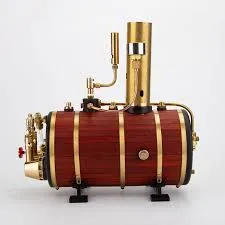
Nov . 24, 2024 22:32 Back to list
Types and Characteristics of Coal-Fired Steam Boilers Explained
Types of Coal-Fired Steam Boilers
Coal-fired steam boilers have been pivotal in the industrial revolution and continue to play a significant role in energy production around the world. These boilers convert the energy stored in coal into steam, which can then be used for power generation, heating, and various industrial processes. Understanding the types of coal-fired steam boilers is essential for optimizing efficiency, performance, and environmental compliance.
1. Fire-Tube Boilers
Fire-tube boilers are among the most common types used in various industries. In a fire-tube boiler, hot gases from burning coal pass through tubes that are surrounded by water. The heat from the gases transfers to the water, creating steam. This type of boiler is known for its simplicity, ease of operation, and relatively lower initial cost. However, fire-tube boilers may not be suitable for high-pressure applications due to limitations in their design and material.
What sets fire-tube boilers apart is their compact size, making them ideal for facilities with limited space. They typically operate efficiently with low operating costs, but they require regular maintenance to ensure that both the tubes and the water remain at optimal levels.
Water-tube boilers are designed to carry water in tubes that are heated externally by fire gases. This design allows for higher pressures and temperatures, making them suitable for large-scale energy production, including power plants. Water-tube boilers can generate steam rapidly and handle fluctuating loads more effectively than fire-tube boilers.
One of their major advantages is safety; should a leak occur in the system, it is less likely to explode as the water is contained within the tubes. Additionally, water-tube boilers are more efficient, allowing for a better fuel-to-steam conversion ratio. They are generally more expensive and require skilled personnel for operation and maintenance.
3. Stoker-Fired Boilers
types of coal fired steam boiler

Stoker-fired boilers utilize a grate system to burn coal. The coal is fed onto a grate where it is ignited and combustion air is supplied underneath. Stoker boilers can burn a variety of coal sizes and types, making them versatile for different environments. They are often used in industrial heating applications due to their ability to burn lower quality coals while still maintaining efficient operation.
Stoker-fired boilers are generally more environmentally friendly than traditional coal burning methods as they allow for better control of combustion conditions, leading to lower emissions. However, they require a higher initial investment and more complex control systems compared to simpler types.
4. Fluidized Bed Boilers
Fluidized bed boilers represent a more advanced technology in coal combustion. In these systems, coal is burned in a bed of ash and particles that are suspended by hot air, allowing for more efficient burning and better heat transfer. This method leads to a more uniform distribution of temperature and minimizes emissions of sulfur oxides and nitrogen oxides, making it an environmentally friendly option.
Fluidized bed boilers can efficiently utilize a wide range of fuel types, including low-grade coal and biomass, thereby increasing fuel flexibility. While they are more expensive to install and operate, their operational efficiency and environmental benefits can be significant in the long term.
Conclusion
Choosing the right type of coal-fired steam boiler largely depends on specific application requirements, fuel availability, environmental regulations, and economic considerations. Fire-tube and water-tube boilers represent traditional choices, each with their own advantages and limitations. Stoker-fired boilers provide versatility in fuel type, while fluidized bed boilers offer advanced technology focused on efficiency and emission reductions.
As industries continue to seek more sustainable energy solutions, the role of coal-fired steam boilers must adapt, potentially integrating with renewable technologies and advanced emissions control systems. Understanding the capabilities and functionalities of each boiler type will be critical for industries aiming to stay competitive while pursuing environmental stewardship.
-
High-Efficiency Commercial Oil Fired Steam Boiler for Industry
NewsJul.30,2025
-
High-Efficiency Biomass Fired Thermal Oil Boiler Solutions
NewsJul.30,2025
-
High Efficiency Gas Fired Thermal Oil Boiler for Industrial Heating
NewsJul.29,2025
-
High-Efficiency Gas Fired Hot Water Boiler for Sale – Reliable & Affordable
NewsJul.29,2025
-
High Efficiency Biomass Fired Hot Water Boiler for Industrial and Commercial Use
NewsJul.29,2025
-
High-Efficiency Biomass Fired Hot Water Boiler for Industrial Use
NewsJul.28,2025
Related PRODUCTS






















